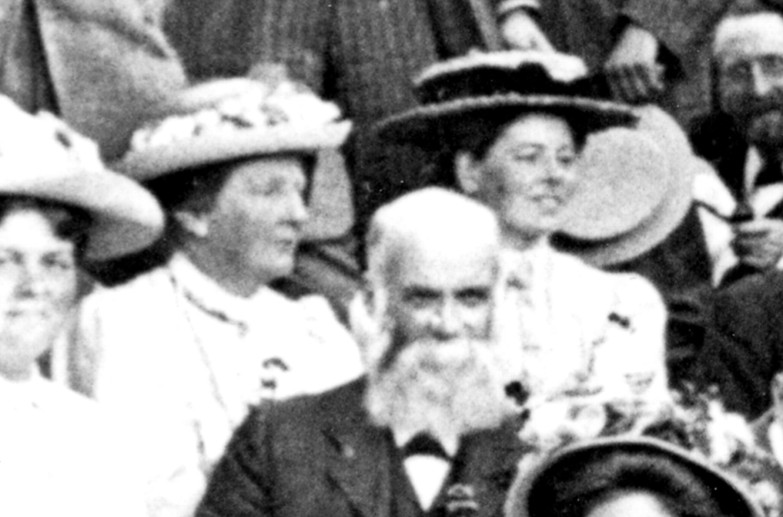
Ethel Skeat (right) and Margaret Crosfield (middle) at Oswestry, 1908 (From Burek and Malpas, 2007)
Women have played various and extensive roles in the history of geology. In the 18th and 19th centuries women’s access to science was limited, and science was usually a ‘hobby’ for intelligent wealthy women. They collected fossils and mineral specimens, and were allowed to attend scientific lectures, but they were barred from membership in scientific societies. It was common for male scientists to have women assistants, often their own wives and daughters. A good example of that was Mary Lyell (1808–1873), daughter of the geologist Leonard Horner and the wife of eminent geologist Charles Lyell. Unfortunately, their contribution has not been widely recognised by the public or academic researchers.
Newnham Hall was founded by Henry Sidgwick in 1875, and was the second Cambridge College to admit women after Girton College. The co-founder of the college was Millicent Garrett Fawcett, primarily known for her work as a suffragist. In 1879, Professor Charles Lapworth, the man who solved the great Cambro-Silurian controversy, encouraged a small group of women at Newnham College to investigate the Silurian and Ordovician rocks of North Wales. Those women were: Gertrude Elles, Ethel Shakespear (née Wood), Ethel Woods (née Skeat) and Margaret Chorley Crosfield.
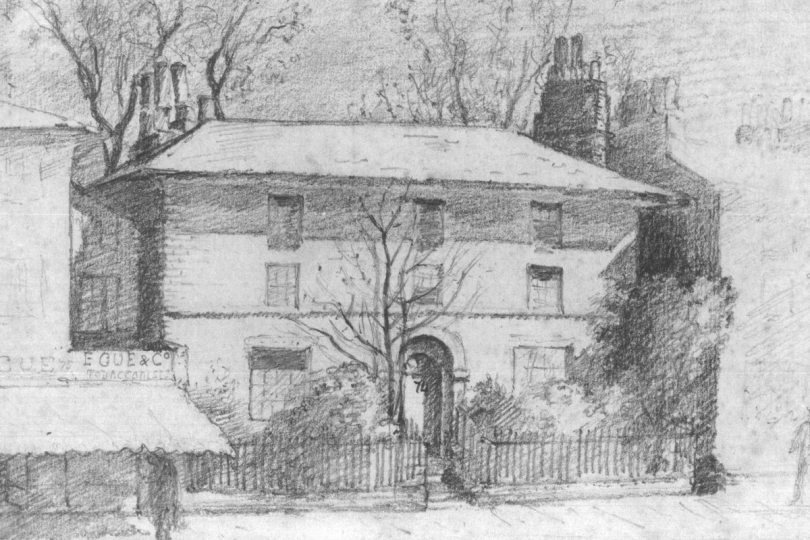
Newnham began as a house for five students in Regent Street in Cambridge in 1871
Ethel Gertrude Skeat was born on 14 May, 1865, in Cambridge, England. She was the third daughter of Professor William Walter Skeat. In 1891, she went to Newnham College, Cambridge, at the same time as Gertrude Elles and Ethel Wood. In Newham, she also met her life-long friend and collaborator, Margaret Crosfield. She completed the Natural Science Tripos certificate part 1, gaining a Class 1 at the age of 29, but without being awarded a degree. In 1893, she joined the Geologists’ Association (GA) and collaborated with her long-time friend, Margaret Crosfield, on their first paper on Welsh stratigraphy in the Carmarthen area, which was published in the Quarterly Journal of the Geological Society in 1896. Ethel won a Bathurst Studentship which she used to go to Munich to work with Karl Alfred von Zittel. She was the first woman to be admitted as a guest to scientific lectures at Munich University after a petition by Professor Zittel. She also collaborated with Victor Madsen on an important work on the Glacial Boulders of the Mesozoic of Denmark. In 1908, she was awarded the Murchison Fund by the Geological Society of London and became the 8th woman to receive any kind of funding from the Geological Society . In 1911, a few months after her marriage with Henry Woods, she became a lecturer at the Cambridge Training College for Women and remained there for 2 years. She died on 26 January 1939 in Meldreth, England.
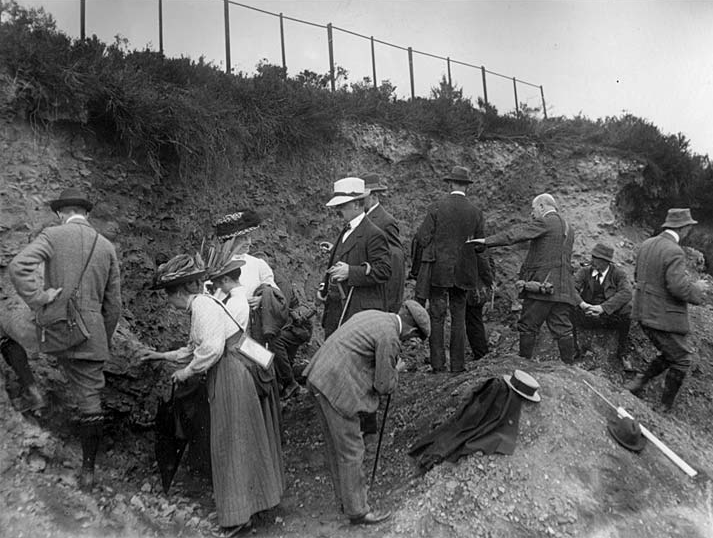
Margaret Crosfield on a Geologists’ Association field trip to Leith Hill with Professor Lapworth (From Burek and Malpas, 2007).
Margaret Chorley Crosfield was born on 7 September 1859 in Reigate, Surrey. She entered Newnham in 1879 at the age of 20 years but her studies there were interrupted by ill health. She returned to complete her studies 10 years later and with the permission of the authorities she only took geology as a subject. She joined the GA in 1892 and 17 years later she was among the first group of women to be elected Fellows of the Geological Society of London. She published three important papers. The first was on Carmarthen with Ethel Skeat that formed the basis of the geological map produced by the British Geological Survey for the area. In 1914, Margaret published with Mary Johnston a work on the Wenlock limestone of Shropshire. Later, in 1925, she published her second paper with Ethel Skeat (now Mrs. Woods) on the geology of the Silurian rocks of the Clwydian Range. She was also a great promoter of women’s suffrage and some of her field notes are written on the back of suffragette notepaper. She died October 13, 1952.
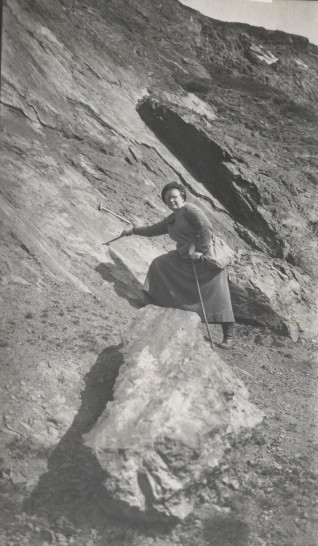
Dr Gertrude Elles (1872-1960), pioneer woman geologist (Image: Sedgwick Museum archives)
Gertrude Lilian Elles was born in Wimbledon on 8 October 1872. She attended Newnham College, Cambridge, at the age of 19 and studied under the guidance of Thomas McKenny Hughes and John Edward Marr, two of the leading geologists of the period. She travelled to Trinity College, Dublin, as one of the ‘Steamboat Women’ to receive her DSc in 1905. Elles was a field geologist, stratigrapher and palaeontologist. Her major work concerned the interpretation of graptolite zones of Lower Palaeozoic strata. Graptolites are extinct marine creatures that formed net-like colonies composed of one or more branches. In the late 1890s, she and her Newnham friend and colleague Ethel Wood began the preparation of British Graptolites (1901-1918), a monograph which was produced in parts over the next twenty years under the general editorship of Professor Charles Lapworth. In 1919 she won the Murchison Medal and became one of the first female Fellows of the Geological Society. She had not an official university position at Cambridge until 1926 when she was appointed to a university lectureship. Ten years later, she became the first woman Reader. She died on November 18, 1960.
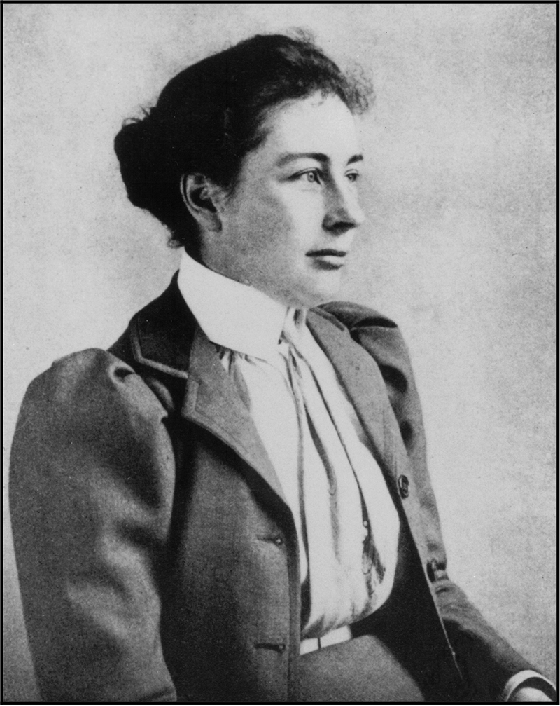
Ethel Wood (1871–1945).
Ethel Reader Wood was born on on 17 July 1871 at Biddenham, near Bedford. Her lifelong friendship with Gertrude Elles began in 1891 when she went up to Newnham College where she obtained a First Class degree specializing in geology. Her first work was a study of rocks in the Lake District, suggested by Professor Marr and undertaken jointly with Elles. The results were published in the Geological Magazine in 1895. A year later, she went to Birmingham University as research assistant to Charles Lapworth. Two of her own publications from this period were especially important. The first was a 1900 paper on the Ludlow formations. The second was her paper on the Tarannon series published in 1906, almost a small monograph on those beds, which made plain their stratigraphic relationship to the better-known Upper Llandovery horizon. In 1904 she won the Wollaston Fund from the Geological Society and the following year she was elected an Associate of Newnham College. She became a Fellow of the Geological Society in 1919 and the following year, shortly after the last part of the monograph came out, was awarded the Murchison Medal. Like Marie Stopes, she gained national recognition not for her geological work but for her social activities, specifically her efforts during World War I. For her public service she received an MBE in 1918 and a DBE in 1920. She died of cancer in 1946.
Thanks to the pioneer work of these women, the 20th century saw the slow but firm advance of women from the periphery of science towards the center of it.
References:
Burek, C.V., and J.A. Malpas, (2007). “Rediscovering and conserving the Lower Paleolithic ‘treasures’ of Ethel Woods (née Skeat) and Margaret Crosfield in northeast Wales.” In Cynthia V. Burek and Bettie Higgs, eds., The Role of Women in the History of Geology. London: Geological Society, Special Publications, vol. 281, pp. 203–226.
C. V. Burek (2007). The role of women in geological higher education – Bedford College, London (Catherine Raisin) and Newnham College, Cambridge, UK, Geological Society, London, Special Publications, eds Burek C. V., Higgs B. 281, pp 9–38.
Creese, Mary R. S.; Creese, Thomas M. (2009). “British women who contributed to research in the geological sciences in the nineteenth century”. The British Journal for the History of Science. 27 (01): 23. doi:10.1017/S0007087400031654
Pingback: Fossil Friday Roundup: October 21, 2016 | PLOS Blogs Network
So nice to read about these women. Thanks for bringing them into the limelight!
Sofie
You are so nice. I think these women are awesome and deserve so much more.
Pingback: Whewell’s Gazette: Year 3, Vol. #26 | Whewell's Ghost
Pingback: Forgotten women of Paleontology: Margaret Benson | Letters from Gondwana.